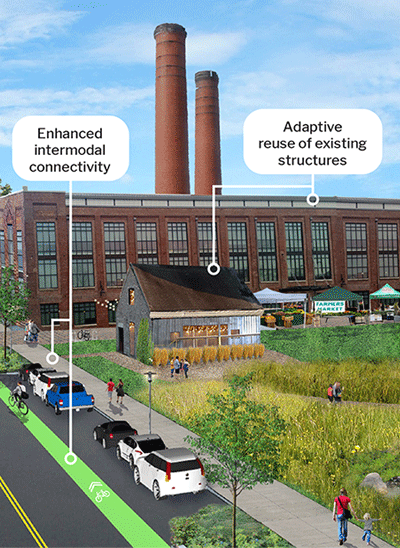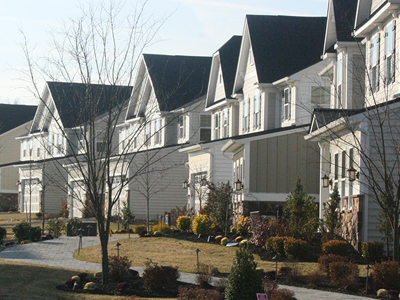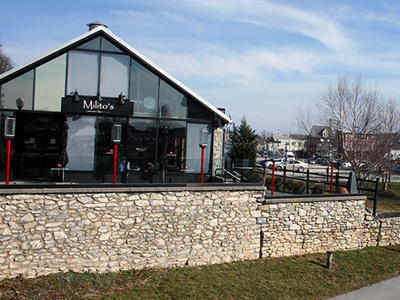The Creamery is an example of how a pop-up beer garden can be successful in an adaptive reuse of a former manufacturing space.
Adaptive reuse of a former paper mill site in Downingtown Borough
How it Works
The EPA estimates that more than 450,000 brownfields are located across the country, with the majority in former industrial/manufacturing "Rust Belt" states, primarily located in the Northeast and Midwest. Brownfields can be caused by the contamination of sites due to multiple prior uses such as old steel mills, chemical or manufacturing facilities, abandoned buildings, dumps, lumber yards, old dry cleaners, and former gas stations or former auto body shops. Brownfields can spur blight and pose quality of life concerns for those living and working nearby. The EPA has documented 592 brownfield sites in Chester County. Many of the documented sites are large tracts of land within or near urban centers—where an increase of 32,115 people and 13,649 new jobs are projected by 2045. Cleaning up and investing in brownfields protects the environment, reduces blight, improves public health and helps take development pressure off undeveloped lands, while encouraging economic development.
The Planning Commission envisions the transformation of brownfields in Chester County into environmentally-safe redevelopment areas that act as an economic development catalyst for the community's future vision. Streamlined processes will implement brownfield redevelopment to encourage the reuse of existing infrastructure, create a sense of place, and enhance the quality of life for residents. Municipalities can encourage the redevelopment of brownfield sites by adopting zoning regulations that allow a range of uses, improving local infrastructure, and working collaboratively with developers to make redevelopment both financially feasible and appropriate for the local neighborhood.
Benefits
Efficient Utility Use
Many brownfield sites have existing utilities, eliminating the need to make costly utility extensions and upgrades.
Economic Development
Redevelopment of brownfield sites into viable uses generates additional tax revenue, creates both temporary construction jobs and permanent jobs, and attracts additional visitors and residents. The EPA has shown that for every $1 of public funds invested in brownfields, $2.48 in private investment is leveraged at the same site.
Community Revitalization
Existing brownfields often have negative impacts on nearby property values. Redevelopment often has a positive domino effect on nearby properties.
Smart Growth
Brownfield redevelopment can support open space preservation by allowing for redevelopment of existing sites, thus supporting compact growth instead of development of green sites. The EPA has shown that for every 1 acre of redeveloped brownfield, an estimated 4.5 acres of greenfields are conserved from sprawl development.
Public Safety
Public safety and quality of life are improved by redeveloping abandoned, underutilized, and contaminated sites into safer more attractive and safe places.
Community Character
The development of brownfields can eliminate previously blighted properties and be transformed into new community assets such as parks.
Transportation Networks
Many brownfield sites are located along major transportation corridors (both rail and auto) or located in currently developed areas and can utilize existing transportation networks.

According to the county's land use vision, brownfields in Chester County will be transformed into environmentally-safe redevelopment areas that act as an economic development catalyst for the community's future vision. Streamlined processes will implement brownfield redevelopment to encourage the reuse of existing infrastructure, create a sense of place, and enhance the quality of life for residents.
Get Started
Municipalities should begin to plan for the redevelopment of brownfield sites through inclusion in their comprehensive, strategic, master, and revitalization plans and ensuring zoning standards are able to accommodate market demand. Regulatory standards should be reviewed and/or updated to be more flexible and appropriate to the community vision. Many brownfield sites are located in former industrial areas surrounded by commercial and residential uses. Municipalities may want to allow for additional uses "By-Right"ty or in an overlay district to encourage development compatible with surrounding uses. Providing density bonuses can help to make brownfield sites more attractive for development.
Outreach to both the public and developers can help with brownfield redevelopment. Municipalities can create and maintain an inventory of brownfield development opportunity sites and actively market these sites to potential developers. Additionally, municipalities can identify and involve potential stakeholders through meaningful community engagement.
The remediation necessary for brownfields can be cost prohibitive to redevelopment. Municipalities can help decrease development costs by streamlining the review process and assisting developers to secure funding. Providing timely review, assisting with community outreach, allowing higher density on brownfield sites, and limiting conditional use and special exception processes can decrease costs associated with long development processes. Municipalities can offer direct incentives such as Tax Increment Financing, tax abatements, and tax incentives, or provide density bonuses for the development of brownfield sites. Municipalities can also help developers navigate state and federal funding sources such as grants, the EPA Brownfield Program, Opportunity Zones, and Low Income Housing Tax Credits.
Additional information on planning for brownfield redevelopment can be found in the Chester County Planning Commission's Commercial Landscapes Series — Stimulating Community Revitalization Through Brownfields.
Considerations
Environmental Remediation
Remediation and site preparation may raise redevelopment costs at brownfield sites. Municipalities can decrease additional costs by creating expedited review processes, providing density bonuses, and minimizing permitting and development fees.
Funding
Financing brownfield redevelopment may include multiple funding sources with a mixture of grants, loans, investments, and tax incentives. Municipalities may need to help developers navigate and secure these funding sources.
Perception of Risk
Brownfield sites may be perceived as lacking development opportunities due to blight, crime, health and safety risks, low property values, and contamination. Municipalities can mitigate negative perception by working with developers and residents to envision the future for these sites.
Regulatory Constraints
Zoning may restrict possible reuse opportunities or require variances. Municipalities can encourage redevelopment through maintaining flexibility at the regulatory level. Municipalities should encourage adaptive reuse in zoning and land development ordinances and related design guidelines. Regulatory provisions should include the allowance of mixed uses and solutions for parking requirements such as off-site satellite and shared parking facilities.
Stormwater Management
Due to the high levels of contamination, additional stormwater management may be needed to limit the amount of new contamination added to remediated soil.
Increased Services Demand
The redevelopment of brownfield sites can add additional demand onto existing transportation and utility networks, as well as addnd new residents who may increase the use ofn public services, such as hospitals and schools.
Balanced Development
Many brownfield sites are redeveloped into mixed-used developments. Communities should maintain a balance between keeping land zoned for industrial use and changing zoning into mixed-use.
Community Character
Many brownfield sites are larger lots of land and can be ideal for larger scale mixed-used development projects. Communities should ensure new development remains compatible with the existing community character while still allowing for larger scale projects.

East Side Flats is an example of how an underutilized property in an urban area can increase the local tax base and establish community social spaces.

Steel Town Village, Phoenixville.
Brownfield sites can be redeveloped into a variety of types of developments including single-family detached housing subdivisions, townhomes, mixed-use, commercial, office, or industrial, parks, playgrounds, or open space. The following are Chester County examples of the various types of redevelopments and the tools used by municipalities to achieve the projects.
Phoenixville Borough
The Phoenixville zoning code includes regulatory standards to promote infill development including the Mixed-Use Infill District, which promotes the redevelopment of former industrial buildings. Phoenixville also included the redevelopment of brownfield sites in their comprehensive plan. The code and plan have enabled projects, such as Franklin Commons, Phoenix Village, and Riverworks.
- Franklin Commons (located at 400 Franklin Avenue) redeveloped a historic industrial building into a mixed-use educational, corporate and recreational facility.
- Riverworks redeveloped a thirty acre former historic steel mill site in Phoenixville into a six building, 349-unit apartment complex. The remediation of the former steel site was undertaken through a grant program offered by the Pennsylvania Department of Community and Economic Development called the Industrial Sites Reuse program (ISRP). The ISRP grant was utilized for the environmental remediation component, specifically capping the site with parking, roadways, and at least two feet of clean fill; removing liquids, sludge, soils, and sediments from former basements and pits; and conducting soil and groundwater attainment sampling.
- Phoenix Village was a brownfield redevelopment project that converted the former Phoenix Steel site into a luxury apartment complex.

The Sharples Works apartments in West Chester was originally a 19th century industrial use. Original structural and surface elements are integrated into the building's interior spaces.
West Chester Borough
West Chester Borough has undergone multiple successful brownfield site redevelopments in the past twenty years. Brownfield redevelopment has predominantly occurred without the need for borough incentives; however, the borough has worked to ensure that the redevelopment of brownfield sites has remained compatible with existing neighborhoods. The borough has included brownfield redevelopment in comprehensive plans, including the revitalization plan, conducted studies on brownfield sites, and used deed restrictions to ensure previously industrial sites are not converted to residential uses.
- Wyeth Site. Located at the corner of South Bolmar and East Nields Streets, the Wyeth site was a former pharmaceutical plant manufacturing penicillin. The site is a brownfield due to chemicals that remain from the plant, which closed in 2004 and was demolished in 2006. The borough has worked to develop the site by including redevelopment of the site in the revitalization plan, completing construction studies for previous proposals, and creating a deed restriction to prohibit residential construction on the site due to contamination.
- Sharples Works. The Sharples Works apartments was originally a 19th century industrial use. Original structural and surface elements are integrated into the building's interior spaces.
- The West Chester Manufactured Gas Plant is a two acre property that had contaminated soil and groundwater from past manufacturing activity. The property was vacant from 1988 until it was remediated in 1996 using Statewide Health Standards and Site-Specific Standards.
- The Santos Auto Center is an auto repair shop which formerly included a gas station. Leaks from storage tanks produced soil and groundwater contamination. The soil has been remediated to meet the Statewide Health Standards and groundwater has met a Site-Specific Standard.

Atwater is located on an old quarry site just outside the Great Valley Corporate Center along the PA Route 29 corridor. When completed it will host a mix of uses which includes: offices, housing options, retail, restaurants and pedestrian amenities.
East Whiteland Township
East Whiteland has one of the highest concentration of brownfield sites in Chester County. The municipality has proactively worked with developers to encourage redevelopment of their brownfield sites, including creating master plans for sites and changing zoning.
- Atwater. Large brownfield sites are often conducive to large scale mixed-use development projects, and one example of this is the Atwater development. Atwater is located on an old quarry site just outside the Great Valley Corporate Center along the PA Route 29 corridor and includes offices, apartments, townhouses, singles, senior housing, a school, and neighborhood commercial.
- Uptown Worthington. This project is one example of how the municipality worked with the developer to create a master plan with new zoning and a phased redevelopment approach to build a mixed-use live, work and play town center on a former brownfield (old steel factory) site. O'Neill Properties group remediated and redeveloped a 77-acre former steel mill site into a mixed-use development project. The brownfield site was transformed into a town center anchored by Wegmans and Target with luxury apartments, retail, restaurant, and office space.




